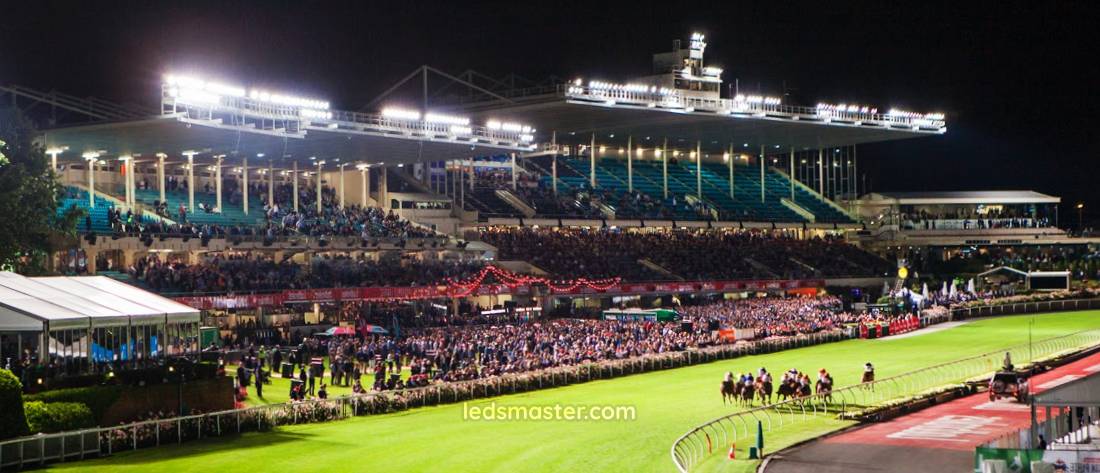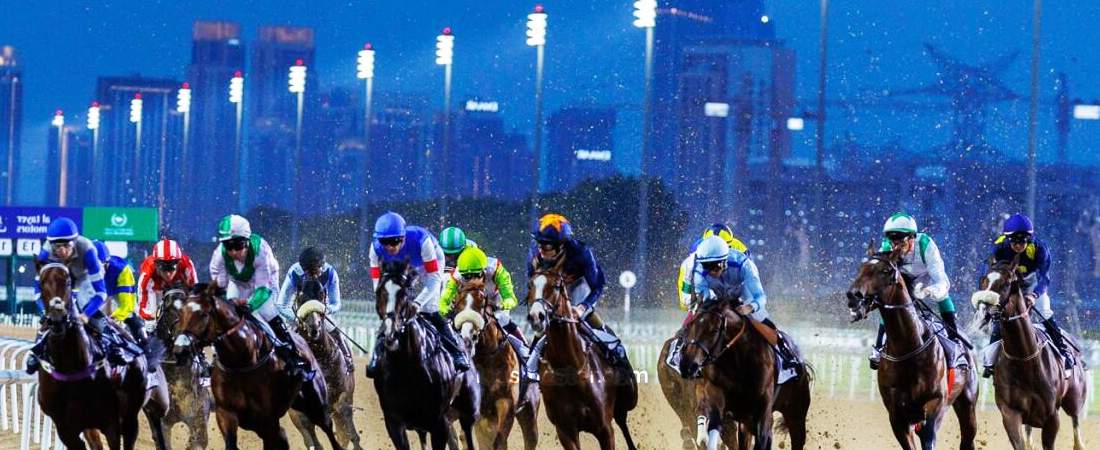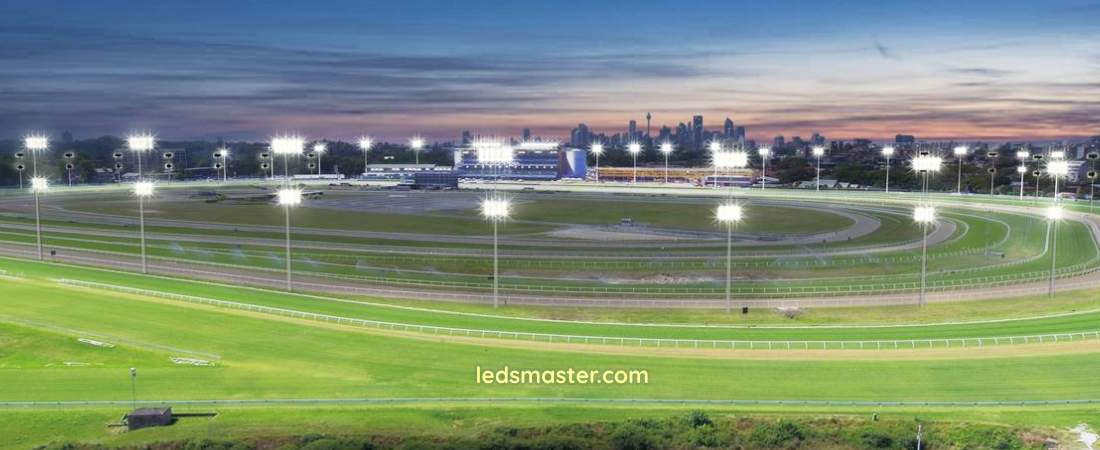Racecourse lighting is more than just a practical necessity—it’s a key ingredient in crafting the excitement and safety of race day. As the sun sets and the track comes alive under the glow of powerful lights, every detail from the jockeys’ determined expressions to the swift gallop of horses becomes crystal clear.
Get your complimentary lighting design today
Lighting design at racecourses is a nuanced discipline, balancing functionality with aesthetics to enhance the experience for spectators, participants, and staff. Effective lighting is necessary to ensure safe and enjoyable events, whether during the day or at night.
Table of Contents
ToggleLighting design at a racecourse serves several functions, each contributing to the overall experience and safety of the venue. One primary goal is to ensure that all participants, including jockeys, horses, and officials, can perform their roles effectively regardless of the time of day. Proper illumination helps in preventing accidents and maintaining clear visibility throughout the course.
Well-designed lighting allows for clear visibility of the racing action, ensuring that viewers can enjoy the event without straining their eyes. For evening and night races, adequate lighting is crucial for creating an engaging atmosphere that keeps the excitement high and allows for accurate viewing.
Additionally, racecourse lighting must support television and media coverage. Broadcast quality can be significantly affected by lighting conditions, with poor illumination potentially leading to inadequate video quality. Effective lighting design ensures that the course looks its best on camera, which is vital for both live and recorded coverage.

Designing lighting for a racecourse involves a thorough understanding of various factors to achieve the desired outcomes. One major consideration is the type of event being held. Different types of races, such as flat racing or steeplechasing, may require different lighting strategies due to variations in the course layout and event requirements.
The layout and structure of the racecourse also influence lighting design. This includes the configuration of the track, the positioning of grandstands, and the placement of viewing areas. Lighting must be carefully designed to ensure uniform coverage across the entire course while avoiding shadows and glare that could affect both participants and spectators.
Another important factor is the local climate and weather conditions. Racecourses located in areas with extreme weather conditions may require specially designed fixtures that can withstand these elements. For instance, lighting systems in regions with high humidity or heavy rainfall need to be waterproof and resistant to corrosion. Similarly, fixtures in colder climates should be capable of operating efficiently in low temperatures.
Safety is a fundamental aspect of racecourse lighting design. The lighting system must ensure that all areas of the racecourse, including track surfaces and surrounding zones, are sufficiently illuminated to prevent accidents. This includes lighting for emergency exits, paths, and other critical areas where visibility is paramount.
When it comes to selecting lighting solutions for racecourses, there are several options to consider, each with its own advantages and suitability for different aspects of the venue.
| Lighting Type | Advantages | Considerations |
|---|---|---|
| LED Lighting |
|
|
| Floodlights |
|
|
| High-Intensity Discharge (HID) Lights |
|
|
LED lighting is a popular choice for racecourse illumination due to its efficiency and performance. LEDs offer high brightness levels while consuming less power compared to traditional lighting technologies. This makes them cost-effective in the long run, as they reduce energy consumption and require less frequent replacement.
Additionally, LED fixtures provide excellent control over light distribution, which helps in minimizing glare and ensuring uniform lighting across the racecourse. They can be dimmed or brightened as needed, providing flexibility to adjust lighting levels based on the specific requirements of different events.

Floodlights are often used to provide broad and intense illumination over large areas, such as the racing track. These fixtures are designed to deliver high-intensity light and can cover extensive areas without creating dark spots. Floodlights are particularly useful for evening and night races, where high levels of illumination are necessary to ensure clear visibility of the racing action.
Modern floodlights often incorporate LED technology, combining the benefits of high brightness with energy efficiency. This integration allows racecourses to achieve powerful lighting while keeping energy costs under control.
High-Intensity Discharge (HID) lights, including metal halide and sodium vapor lamps, have traditionally been used in racecourse lighting. These fixtures are known for their high lumen output and ability to cover large areas. HID lights are effective in providing the bright illumination needed for racecourses, especially for night events.
However, HID lights can be less energy-efficient than LEDs and may require more maintenance due to their shorter lifespan. Despite these considerations, they can still be a viable option depending on the specific needs of the racecourse and the budget available for lighting upgrades.
Trackside lighting is designed to enhance visibility along the edges of the racecourse. This type of lighting helps in clearly defining the track boundaries and ensuring that any obstacles or hazards are visible to both participants and spectators. Trackside lights are typically mounted on poles or structures positioned around the track to provide focused illumination.
This type of lighting can be customized to suit the specific layout and needs of the racecourse. It plays a crucial role in maintaining safety and ensuring that the racing action is clearly visible from all vantage points.
Illumination of spectator areas is also a consideration in racecourse lighting design. Adequate lighting in grandstands, viewing areas, and concourses ensures that spectators can enjoy the event comfortably and safely. This lighting needs to be bright enough to allow for clear viewing while also creating an inviting atmosphere for attendees.
Effective spectator area lighting also contributes to the overall ambiance of the racecourse. By using well-designed fixtures that complement the venue’s aesthetics, racecourses can enhance the experience for visitors and create a visually appealing environment.
These lights are designed to illuminate exit routes, emergency access points, and other critical areas during an emergency situation. Proper placement of emergency lighting ensures that all areas are clearly visible, enabling a swift and safe evacuation if necessary.
In addition to providing safety during emergencies, these lights must be reliable and able to function even in power outages. This reliability is crucial for maintaining safety standards and ensuring that the racecourse remains operational in all conditions.
Advanced lighting control systems allow for precise management of illumination levels and patterns across the racecourse. These systems can be programmed to adjust lighting based on different scenarios, such as day or night races, weather conditions, and specific event requirements.
Control systems can also help in reducing energy consumption by optimizing lighting levels and turning off lights when they are not needed. This flexibility not only enhances the functionality of the lighting system but also contributes to overall cost savings.

Once the lighting design has been finalized, the implementation phase involves the installation of the selected fixtures and systems. This process requires careful planning to ensure that all components are correctly positioned and configured according to the design specifications. Proper installation is essential for achieving the desired lighting effects and ensuring the longevity of the system.
Regular inspections and servicing help in identifying and addressing any issues before they affect the performance of the lighting. Maintenance tasks may include cleaning fixtures, replacing bulbs or LEDs, and checking electrical connections.
By adhering to a well-structured maintenance plan, racecourses can ensure that their lighting systems continue to operate efficiently and effectively, providing a safe and enjoyable experience for all participants and spectators.
Racecourse lighting design is a complex field that requires careful consideration of various factors to achieve optimal results. From ensuring safety and visibility to enhancing the spectator experience, effective lighting design plays a key role in the success of racecourse events. With the right combination of lighting solutions and careful planning, racecourses can create an engaging and enjoyable environment for all involved.
Racecourse lighting design encompasses a range of considerations and solutions aimed at enhancing both functionality and aesthetic appeal. By focusing on key objectives such as participant safety, spectator experience, and media coverage, racecourses can create an environment that supports high-quality events, regardless of the time of day.
The design process involves a careful balance of various factors, including the specific needs of the racecourse, local climate conditions, and the type of events hosted. Selecting the right types of lighting solutions—such as LEDs, floodlights, HID lights, and trackside illumination—plays a crucial role in achieving the desired outcome.
Implementing and maintaining an effective lighting system requires thorough planning and ongoing attention. With well-designed lighting systems, racecourses can ensure optimal visibility, safety, and overall enjoyment for participants and spectators alike. By investing in thoughtful lighting design and regular maintenance, racecourses can enhance their events and create memorable experiences that shine brightly.